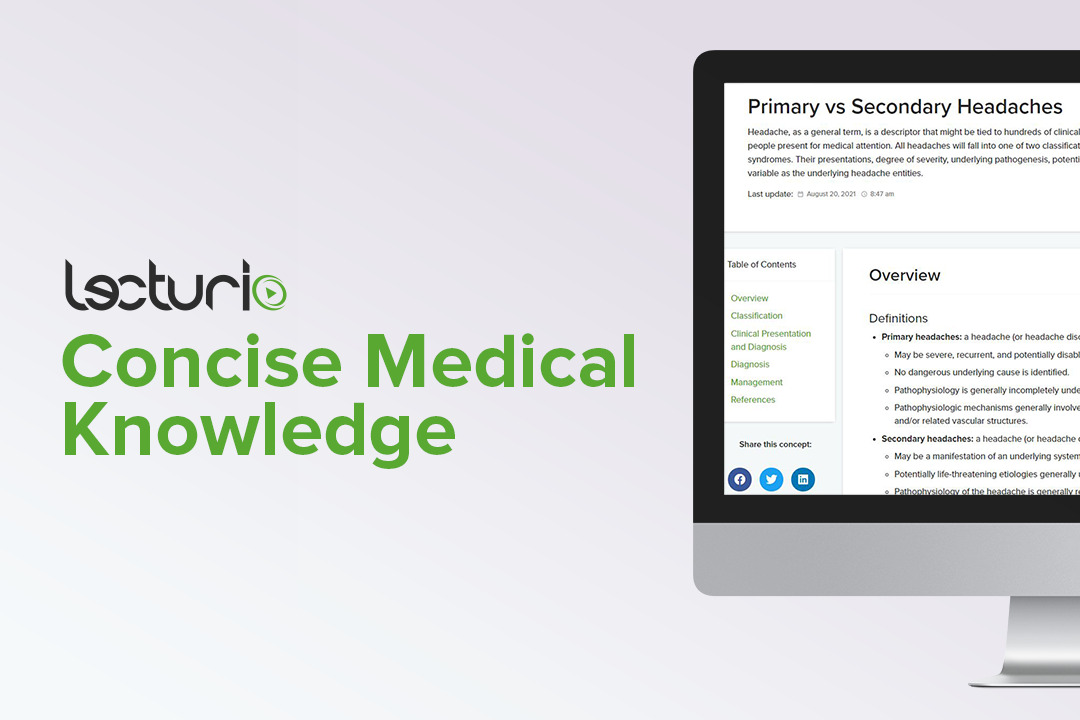Playlist
Show Playlist
Hide Playlist
Case: 25-year-old Man with Cluster of Headaches
-
Slides Headaches Paroxysmal Episodic Headaches.pdf
-
Download Lecture Overview
00:01 So that's migraine and tension type headaches, two very important headache syndromes to understand. 00:06 Let's now shift to talk about the chronic recurrent episodic headaches with prominent autonomic features. 00:12 And we'll talk about the Trigeminal Autonomic Cephalalgias. 00:16 And let's do so through a case. 00:19 This is a 25-year-old man who presents with new cluster of headaches. 00:23 The headaches are described as orbital and feel like a boring, pulsating, deep-quality pain that stays on one side of the head but switches sides in between clusters of headaches. 00:35 So it's always on one side within a cluster, but between the episodes of clusters can change sides. 00:42 The headaches are extremely severe and have been clustering at night, keeping the patient awake and he has not been able to sleep lasting 30-60 minutes each. 00:51 In addition, the patient describes autonomic signs on the same side as the pain. 00:55 This includes tearing and runny nose or rhinorrhea. 00:59 On exam, the patient has a non-focal neurologic exam but an erect posture is pacing the room and agitated clearly in pain. 01:07 So what type of headache syndrome is this? With a number of features that reinforced that this is an episodic and chronic recurrent headache syndrome, with episodes that occur in clusters and clusters that are separated from one another episodes of clusters, many would describe. 01:27 And here we see prominent autonomic features. 01:30 So tearing and runny nose, which we didn't hear with our patients with migraine and tension type. 01:36 In addition, the headache is locked to one side it's unilateral and a duration that's 30-60 minutes. 01:42 All of these features are pointing us towards a trigeminal autonomic cephalalgia. 01:48 Is this a primary or secondary headache syndrome? Well, this is a primary headache syndrome And in this case, we can proceed to treatment. 01:57 We may consider some evaluation in selected patients but we need to move to treatment for this patient who really has a very severe headache syndrome at this time. 02:06 So what type of headache is this? Is this migraine? Is this tension type, is this cluster or is it subarachnoid haemorrhage? Well, that doesn't sound like subarachnoid haemorrhage. 02:16 That was thunderclap headache. 02:17 And this does not have a thunderclap description. 02:20 It doesn't have that rapid and severe onset within 1 minute or 60 seconds. 02:24 It's a severe headache, but doesn't meet the criteria for thunderclap. 02:28 It doesn't sound like migraine, it's chronic and recurrent. 02:32 But this patient has prominent autonomic features, has a unilateral side locked headache. 02:37 We don't see that unilateralality locked to one side and migraine and that really supports a diagnosis of attack of trigeminal autonomic cephalalgia. 02:46 Likewise, tension type doesn't seem like the right diagnosis here. 02:50 Tension type is a chronic recurrent headache syndrome, but it is typically bilateral holocephalic with a band like sensation. 02:57 This patient has cluster. 02:59 And this is the typical description of a cluster headache.
About the Lecture
The lecture Case: 25-year-old Man with Cluster of Headaches by Roy Strowd, MD is from the course Headache.
Included Quiz Questions
Which of the following describes the nature and location of pain with cluster headaches?
- Stabbing and unilateral pain associated with tearing
- Stabbing pain located in the occipital area
- Throbbing and unilateral headache
- Dull band-like pain around the head
- Unilateral headache associated with nausea and vomiting
What is a feature of cluster headaches that differentiates them from migraine and tension-type headaches?
- Cluster headaches have prominent autonomic features.
- Cluster headaches present as "thunderclap-type" headaches.
- Migraine headaches have prominent autonomic features.
- Tension headaches are usually unilateral.
- Migraine headaches are often holocephalic with "band-like" pain.
Customer reviews
5,0 of 5 stars
| 5 Stars |
|
5 |
| 4 Stars |
|
0 |
| 3 Stars |
|
0 |
| 2 Stars |
|
0 |
| 1 Star |
|
0 |




